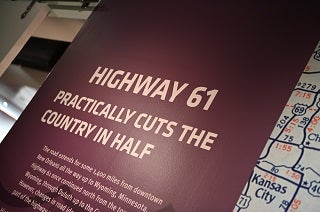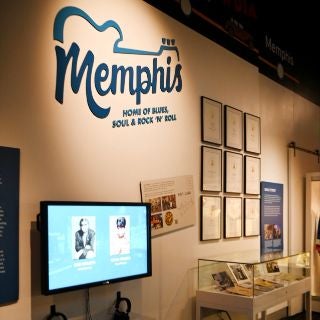
Highway 61: Traveling America's Music Highway
- GRAMMY Museum MS 800 W Sunflower Rd Cleveland, Mississippi 38732
- Aug 11, 2023 Through Aug 25, 2024
-
TUES - SAT: 10 AM - 5 PM
SUNDAY: 12 PM - 3 PM
Presented by Eutaw Construction, in collaboration with Commissioner Willie Simmons, the first-of-its-kind exhibit will take visitors on a journey down what could be considered to be music’s most important and famous road—Highway 61—while exploring the music sites and celebrating the artists that played a major role in shaping American music history. The exhibit will be on display through 2024. Supporting sponsors include APAC Mississippi and South Delta Planning and Development.
Highway 61 stretches through Mississippi from Memphis in the North down to the Louisiana line in the South. The highway’s full length goes from Wyoming, Minn., to New Orleans, but Mississippi’s stretch has arguably contributed the most to American music history. While its famously known as the Blues Highway, Highway 61 also saw countless African American migrants escaping the Jim Crow system and changing agricultural patterns in the Mississippi Delta and Deep South, known as the Great Migration. When World War II created shortages in labor, Highway 61 served as the primary road for thousands of African Americans who were fleeing the harshly segregated South in search of better lives in cities like Chicago, Detroit, St. Louis, and Philadelphia.
While Highway 61 stretches from Louisiana to Minnesota, Mississippi’s part of Highway 61 is arguably the most iconic. Its passage through Mississippi’s Delta region is what gives Highway 61 its widely known moniker, the Blues Highway. I am thrilled that GRAMMY Museum Mississippi is bringing the story of America’s most important highway to life through this exhibit, and I can’t wait for visitors near and far to experience it.
Jon Hornyak, Sr. Executive Director of the Recording Academy’s Memphis Chapter
Highway 61 has also played a pivotal role in Mississippi blues history. It is said that Robert Johnson sold his soul to the devil at the intersection of Highways 61 and 49 in Clarksdale, Miss. Additionally, in 1941 a sharecropped named McKinley Morganfield sat down for a recorded interview with John Work and Alan Lomax in Clarksdale. After he heard his voice and guitar played back for him for the first time, Morganfield left the Delta and traveled the Illinois Central Gulf rail line, which paralleled Highway 61, to Chicago where he changed his name to Muddy Waters and forever changed music history.
Passing through Tunica and Clarksdale through Cleveland, Vicksburg, and Natchez, Highway 61 carries incredible stories that have shaped much of music history, especially the blues. We can’t wait to share these stories with our visitors through this first-of-its-kind exhibit. We’d like to thank our sponsors for making this exhibit possible, Commissioner Willie Simmons for his support, and the Museum Curatorial team for helping bring it to life.” Emily Havens, Executive Director, GRAMMY Museum Mississippi
It’s an honor to have our very own GRAMMY Museum Mississippi, in collaboration with our sponsors from the transportation infrastructure industry, to recognize Highway 61- the Blues and Heritage Highway- by featuring some of the many contributions Highway 61 had in making Mississippi the Birthplace of America’s music. Countless Mississippians have traversed Highway 61—from legendary musicians to the African Americans who left the segregated South during World War II in hopes of finding better opportunity in other parts of the country. Thank you to the Mississippi Museum for sharing this important story.”
Willie Simmons, Mississippi Central Transportation Commissioner
The exhibit will feature iconic artifacts from artists like Muddy Waters, Ann Peebles, Dr. John, Bobby Rush, and Conway Twitty, among others, along with artist interviews, interactive experiences, and even a Juke Joint. The exhibit will also include a section dedicated to the celebration of the Recording Academy Memphis Chapter’s 50th anniversary, highlighting key moments from the Chapter’s history.



